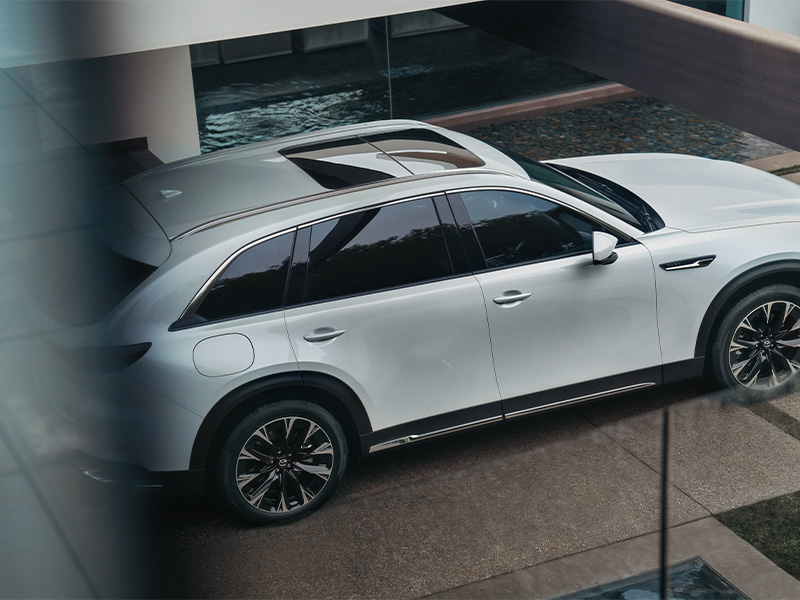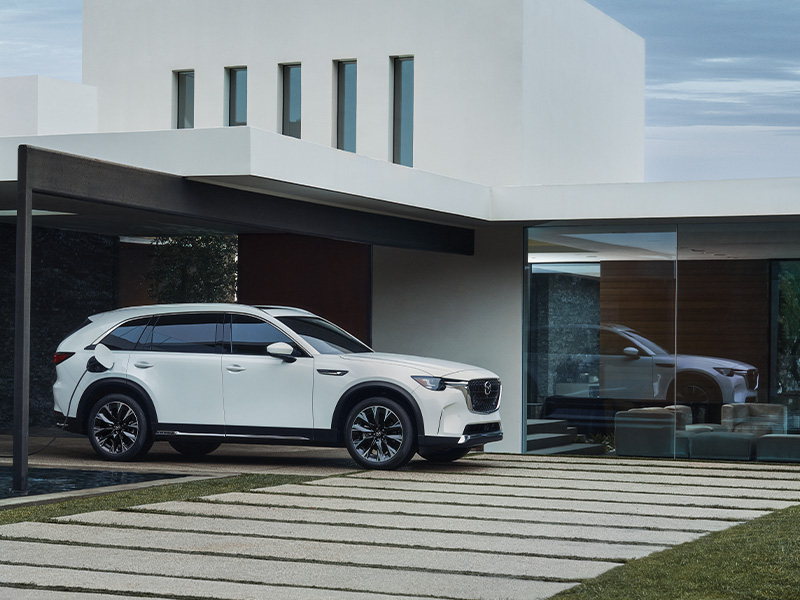Why Should I Get an Electric Car?
Electric vehicles are an undeniable player in the U.S. automobile market, and an increasing number of drivers are showing interest in purchasing an electric vehicle (EV) for their next automobile. Beyond the increasing number of types of EVs available to choose from, these cars offer practical, financial, and lifestyle-related benefits for their owners.
But should you get an electric car? Let’s take a comprehensive look at the different factors that may or may not make the purchase of an EV appealing, depending on your driving habits and needs.
10 benefits of electric cars
1. There are more electric and electrified options than ever before
Electric vehicle sales have more than doubled since 2018, and manufacturers have continued to expand their electric vehicle offerings, from battery-electric vehicles (BEVs) to plug-in hybrid electric vehicles (PHEVs), to accommodate this growing interest. Take, for example, the Mazda CX-90 PHEV, a 3-row PHEV with room for the whole family — quite different from the more stereotypical EV sedan.

What is clear is that the market now provides an array of exciting EV models, making it easier than ever before for individuals to own an electric vehicle they enjoy.
2. Fuel economy and EV range have vastly improved
When they were first introduced into the mainstream market, EVs had a relatively limited range compared to their internal combustion engine (ICE) counterparts. But EV driving ranges have continuously improved, to the point where virtually all new BEV models today can travel more than 100 miles on a single charge. The majority easily exceed 200 miles.
Hybrid electric vehicles (HEV) and PHEVs have also improved fuel economy compared to traditional ICE cars, reducing tailpipe emissions, while EVs running solely on electricity emit no emissions at all.
3. At-home charging is easy and convenient
Charging your EV or PHEV at home is the least expensive method of replenishing your EV battery, and is most commonly done during overnight hours when electricity is most available and least expensive. An increasing number of homes now come equipped for Level 2 charging; if yours does not (and does not have a 240V grounded outlet) having one installed does require upfront costs, but can offer long-term convenience.
Level 2 chargers can usually charge a standard BEV battery from empty to 80% in about 4-10 hours (assuming a 60 kWh battery) and a PHEV's smaller battery considerably quicker. For example, the Mazda CX-90 PHEV's 17.8 kWh battery can be charged from 20 to 80% in about 1.5 hours on Level 2. If installing a Level 2 charging system in your home isn’t an option, you can charge your PHEV using a standard 120V outlet overnight, in 5-6 hours, if charging from empty (assuming an 8 kWh battery).
It’s easier to access and install an EV charging station at a single-family dwelling versus a multi-family housing complex. Infrastructure surrounding EV charging for apartments and condos needs improvement.
4. The public charging network is growing and becoming more standardized
The lack of accessible and reliable public charging stations in some areas of the nation has dissuaded many prospective EV buyers in the past, but recent laws aim to build out EV charging infrastructure in the U.S. One such effort is the National Electric Vehicle Infrastructure (NEVI) Formula Program, a $5 billion federal effort designed to help states build out EV charging stations and improve the reliability of the current EV charging station network.
As part of the program, the Electric Vehicle Charger Reliability and Accessibility Accelerator will also provide $100 million in funding to repair and replace publicly available EV charging infrastructure.
5. EVs are well-suited for city driving and commuting
Electric vehicles make great commuting vehicles because they’re very efficient in the stop-and-go traffic. That’s in part because EVs are designed with regenerative braking systems that put less strain on your vehicle’s brakes and recover energy when braking, giving your battery a boost.
6. Reduced fuel and maintenance costs, particularly when buying new
On average, electric vehicle drivers save $700 a year in fuel costs compared to traditional ICE vehicles. The electric motor in an EV has fewer moving parts that wear and potentially fail, meaning you’ll have lower vehicle maintenance costs to worry about when you switch to an EV.
To learn more, see our article: EV Maintenance Considerations.
7. EVs handle and perform well
If you’ve ever worried that saying goodbye to your internal combustion engine vehicle would mark the end of your ability to accelerate quickly, you can rest assured that’s not true. In addition to being smooth and quiet, the electric motors of EVs deliver torque instantly, allowing for rapid acceleration. The word that is used to describe them again and again is “zippy.”
In addition, thanks to the low position of the battery pack — the heaviest component in an EV— EVs have a lower center of gravity. A lower center of gravity improves handling and stability for any vehicle and is one reason sports and racing cars are low to the ground.
8. EV tax credits and other incentives
The Inflation Reduction Act created incentives for electric vehicle ownership in the form of the Federal Electric Car Tax Credit, which provides up to $7,500 for buyers who purchase a new EV in 2023 or after. There are limitations — the rule has been amended so only vehicles that are made primarily in the US qualify— and there are income caps.
This has limited the number of EVs that qualify for this credit currently, but leased EVs don’t have to meet the same specifications, making leasing an attractive alternative.
It’s also worth checking for local EV tax incentives; the US Department of Energy’s Alternative Fuels Data Center can help you easily find incentives you’ll qualify for in your state.
9. Home charger incentives
In addition to tax incentives for buying a new EV, you can also qualify for home charger incentives. If you decide to install a Level 2 charger at your home, you can take advantage of a tax credit that covers up to 30% of the total cost, including both the hardware and installation expenses, with a maximum benefit of up to $1,000.
Started in 2023, this tax credit extends to a broader range of EV charger equipment, encompassing bidirectional (two-way) chargers for both residential and business installations, making it more accessible and financially appealing for those interested in investing in this innovative technology.
10. PHEVs can eliminate range anxiety
If you want an EV but not able to commit to a BEV for whatever reason, plug-in hybrid electric vehicles, which feature both an electric motor and combustion engine, help eliminate range anxiety. When the battery in a PHEV gets low, the vehicle automatically switches to using the gasoline engine. The combination of technologies in PHEVs provides valuable peace of mind for drivers who may be concerned about the range of all-electric vehicles.

Should I buy an electric car?
The pros of EV ownership, including reduced emissions, lower operating costs, and the potential for government incentives, make EVs a compelling choice. At the same time, it's important not to ignore the potential challenges surrounding EV ownership, such as a potential lack of charging infrastructure in your area and the relatively high initial costs of today’s EVs.
To help you decide whether driving an electrified vehicle is right for you, ask yourself and answer the following questions:
- Range: How many miles do you typically drive a day, and do you plan on regularly using your next vehicle for long trips on the road?
- Type of EV: What kind of EV fits your needs? An all-electric vehicle (BEV), plug-in hybrid electric vehicle (PHEV), or traditional hybrid vehicle (HEV). Or even a fuel cell electric vehicle (FCEV)?
- Charging infrastructure: If you’re considering a BEV or PHEV, is your home equipped for Level 2 charging? If not, will you have it installed and/or do you have reliable access to a public Level 2 or Level 3 charger in your area (the latter typically usable for BEVs only)?
- Budget: How much do you have put aside for a down payment? What would a comfortable monthly car payment look like for you? Are the EVs you’re interested in eligible for federal or municipal tax credits? (And does your household income fall within the eligible range?)
- Purchase type: Do you plan to purchase your EV outright, finance your purchase, or lease?
Ultimately, electric cars are an increasingly viable alternative to ICE vehicles for many potential car buyers, but whether buying an electric vehicle makes sense for your lifestyle depends on your individual needs — as it always has with ICE vehicles as well.
Experience the Mazda Selection of Electrified Vehicles
The Mazda CX-90 PHEV and CX-70 PHEV offer the power and versatility of an internal combustion engine combined with the fuel economy of an electric motor for shorter trips, giving drivers the best of both worlds, and for those looking for a full hybrid vehicle, look no further than the CX-50 Hybrid.
Explore the various ways you can make these vehicles yours online or find a Mazda Dealer near you to take a test-drive today.

This article is intended for general informational purposes only and is based on the latest competitive information available at the time of posting. Information herein is subject to change without notice and without Mazda incurring any obligations. Please review a variety of resources prior to making a purchasing decision. Visit Resource Center for more articles.





















